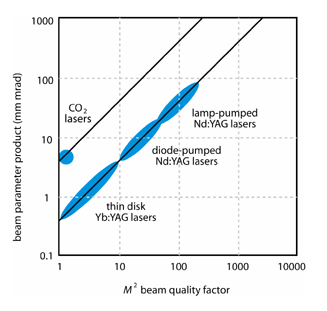Optipedia • SPIE Press books opened for your reference.
Carbon-Dioxide Lasers
Excerpt from Field Guide to Lasers
Carbon-dioxide (CO2) lasers are powerful and comparatively efficient gas lasers emitting at 10.6 µm or at other wavelengths around 9-11 µm. A gas discharge excites nitrogen molecules, which transfer their energy to the laser-active CO2 molecules.
CO2 lasers of different types span a wide range of powers-from tens of watts to many kilowatts or even several megawatts. While low-power versions can work with a sealed tube (no-flow lasers), high-power lasers use a fast gas flow. Continuous-wave and pulsed operation are possible.

Even at high power levels, CO2 lasers often reach nearly diffraction-limited beam quality. Due to the longer wavelength, the beam parameter product is larger than that of diffraction-limited solid-state lasers (e.g., thin-disk lasers), but it is still smaller than that of many solid-state lasers with nonideal beam quality. The figure above gives a rough indication of the typical parameter regions.
Properties of Carbon-Dioxide Lasers
| Aspect | Properties |
| important types | multi-kW TEA lasers; low-power, sealed-tube lasers |
| applications | laser cutting an dwelding; laser marketing |
| pump source | electrical current |
| power efficiency | order of 10% |
| accessible wavelengths | mostly around 10.6 μm with otherlines at 9-11 μm |
| wavelength tuning | quite limited |
| average output power | typically between 1 W and 50 kW |
| beam quality | normally diffraction-limited |
| continuous-wave operation | yes |
| nanosecond pulse generation | yes, with mode locking or Q switching |
| picosecond & femtosecond pulse generation | no |
R. Paschotta, Field Guide to Lasers, SPIE Press, Bellingham, WA (2008).
View SPIE terms of use.

